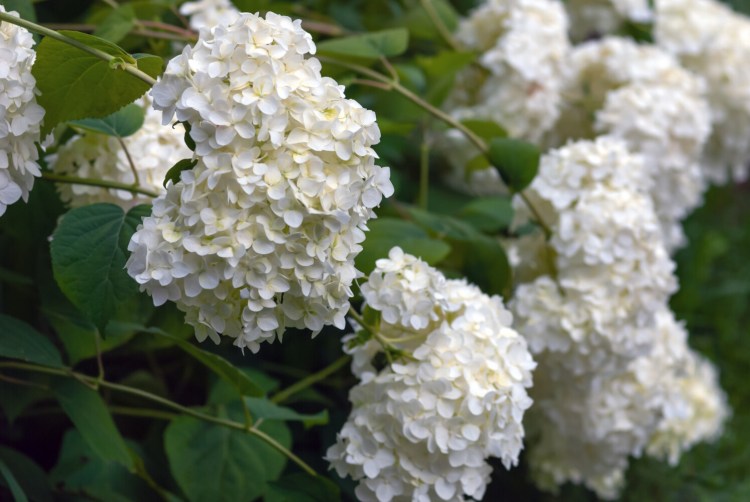Hydrangeas are gorgeous. They also are irritating.
When everything works, hydrangeas produce huge, lush blossoms that can reach eight inches in diameter in white, blue, pink and even red. All stand out wonderfully in the landscape.
When things don’t work, hydrangeas are a stand of ugly cream-colored sticks that are a blot on the landscape through a good part of the summer.
Michael Dirr – the renowned horticulturist who wrote the tree and shrub manuals found in every garden center in the nation – has a lot to answer for.
Before the 21st century, hydrangeas were an old-fashioned plant that grew in cemeteries and at old homes. Hydrangea paniculata grandiflora, or ‘PeeGee’ hydrangea, grows 10 feet tall and produces white blossoms that turn pink and bronze as they age – the blossoms last until winter. They were popular, and you can still see them in cemeteries and Victorian homes.
‘Annabelle,’ a variety of Hydrangea arborescens with large double white flowers, was also popular, in part because it can stand some shade.
A few courageous gardeners planted ‘Nikko Blue,’ a short Hydrangea macrophylla, that was striking for its deep, blue flowers.
Then in 1998, Dirr was wandering around Bailey Nurseries in Minnesota and saw a macrophylla hydrangea that bloomed on both old and new wood. He took some samples to his University of Georgia nursery and produced the ‘Endless Summer’ hydrangea, which took the industry by storm when introduced in 2004.
The variety, however, can be finicky in Maine. Sometimes the winter cold kills the past year’s branches, so the plants show nothing but cream-colored sticks until this year’s growth covers them or the gardener cuts them away. Other times, they produce lush foliage but few blossoms. Occasionally, though, ‘Endless Summers’ are particularly happy and produce huge, gorgeous blossoms in several shades of blue.
That’s the other secret. They produce blue blossoms in acid soil, which in Maine is predominant. In basic soil, the blossoms are pink. And around many homes, where ground limestone has been added to the soil so the lawn grows better or close to concrete foundations that also leach lime, the blossoms are pink unless a soil acidifier is added.
Since 2004, hydrangea hybridizers have been busy, introducing dozens of new varieties each spring. Maine garden centers list 30 to 50 different varieties each, and there are hundreds more online.
In our garden, we prefer the older varieties. We have ‘Annabelle’ and ‘PeeGee.’ We even have some ‘Endless Summers’ left over from when they were new.
A couple weeks ago, I was shocked to find a really gorgeous hydrangea growing in a shady part of our yard, and I had no idea what it was. There is a reason for that. Because I am a garden columnist, companies sometimes send me plants to test out. This was one of those plants, but I couldn’t find the label or the plant description that came when I got it three or four years ago.
I posted the photo on Facebook, and Tom Estabrook of Estabrook’s in Yarmouth and Al Lappin Jr. of Lappin Landscaping in Scarborough agreed that it’s probably ‘Tuff Stuff,’ developed by Proven Winners, a national plant wholesaler. It is Hydrangea seratta, or a mountain hydrangea.
Mountain hydrangeas are fairly new to the U.S. market, native to the mountains of Korea, so tough enough to thrive in Maine, and tolerant of shade. They also are naturally compact, so they don’t have to be pruned. They are easy to grow, said Andi Ross of Nature’s Way landscape design in Massachusetts at a Maine Flower Show lecture back when large public gatherings still existed.
I am not going to wholeheartedly tell everyone to buy this plant because; as baseball fans know, anyone can have one good year. But it is something to watch.
Here are a few ideas for hydrangeas that are improvements over the varieties my wife Nancy and I planted in the 1970s and ’80s.
Instead of Annabelle, which flops because the blossoms are too heavy for the stems, plant ‘Incrediball,’ which has stronger stems and even bigger blooms. If you want a pink Arborescens, go with ‘Invincibelle Spirit’ and its kin. ‘Haas Halo’ is a lacecap Arborescens that has grown well for us, in shade, for two years.
For Paniculata hydrangeas, I like ‘Pinky Winky’ and ‘Quickfire’ for their earlier bloom times and more interesting colors. For Marcrophyllas, try the multicolored ‘Twist and Shout’ and shade-tolerant ‘Blue Enchantress.’
Arborescens is a U.S. native, as is the climbing hydrangea (quercifolia), also called oak leaf hydrangea. Oak leaf hydrangea doesn’t reliably bloom in Maine, but when it does, it is gorgeous. The leaves alone make it worthwhile. The others are not native.
If you want to aid pollinators, go with lacecaps. The double flowers like ‘Annabelle’ are sterile, and no help to bees and butterflies.
Now, a couple hints for growing hydrangea.
Don’t prune a hydrangea just so it will fit into a space. We prune ‘Annabelle’ because, left to its own, it would spread and take over the yard. If you want a ‘Pee Gee’ but don’t want it at 10 feet, pick a dwarf variety. Leave the blossoms on all winter, and be aware that if you prune in spring – even March – you are cutting off next year’s blossoms.
Water a lot. Hydrangea translates in Greek to water vessel. They are thirsty shrubs.
Don’t fertilize the plants or even the lawn near them. That promotes the growth of the foliage and limits the flowers.
Your yard already has too many all-green plants.
Tom Atwell is a freelance writer gardening in Cape Elizabeth. He can be contacted at: tomatwell@me.com
Send questions/comments to the editors.


